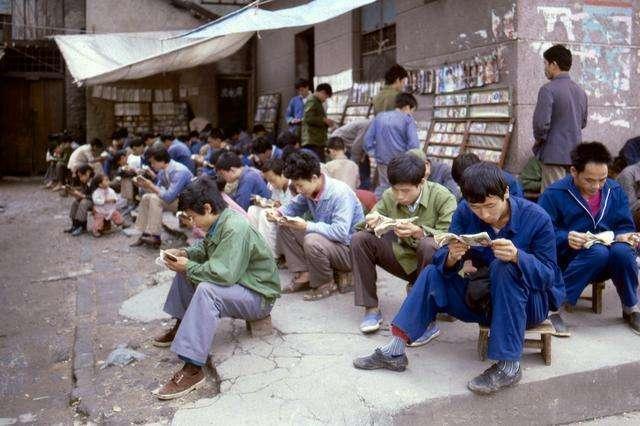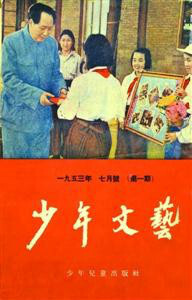最早看的应该是小人书(连环画,我们通常称之为“小书”)。好像家里并没有买很多小人书。大部份是借来看的,或去书摊租来看。离家不远的地方就有一个小书出租店。可以坐在店里看(1分钱一本),也可以租回家看(2-3分钱一本,2-3天)。有的一套小书有几本,装订在一起的,稍贵一些。

年纪稍大一点看的书就杂一些。记得有杂志,如《少年文艺》等。有小说或历史故事等,印象较深的有《三国演义》单行本,《卓娅和舒拉的故事》,《跟随毛主席长征》等。一位邻居家有全套《红旗飘飘》好像看过好几本。那时候这一类书居多。文化革命开始后,看的书就有更多限制了。看的大多是无封面,无封底的书,如《青春之歌》,《林海雪原》,《铁道游击队》,还有很多,很多。那时看书有很多字不认识,也不会读(现在还是这样:0),这些字就猜测意思,或就跳过去了,或就读白字。有一次还在小学的时候(可能是3-4年级),和一位同龄朋友一起看竖排版的三国演义单行本,两人都不认识三国名将“趙云”的姓,我们在一起议论这故事时就称他为“肖云“。(我们当然不知道这是读错了。)

《少年文艺》首刊,1953年7月 (来自网络)
中学期间看的书更广一些。《水浒》,《红楼梦》都在这时候看的(都还属于禁书)。也看过一些手抄本小说。文革结束后,文学开放得很快。表姐买了很多外国文学名著译成中文的书,如《红与黑》,《高老头》,《安娜. 卡列尼娜》,《悲惨世界》,《傲慢与偏见》,《大卫. 科波菲尔》,《双城记》,《罪与罚》,《简. 爱》等。我大多都读了,收益匪浅!很多文艺杂志也开始发行,如《十月》,《当代》,《人民文学》,《小说月报》,《中篇小说》等,我也读了很多。读书受益终身。
Reading
I think my reading started with cartoons (the Chinese version of cartoon books, we usually call them “books for the small people” or simply “small books.” I don’t think we bought a lot of cartoon books. Most of these small books were rented or borrowed. There was a small rental store that specialized in cartoons. You can sit there reading with a price like 1 cent per book, or you can take the book home for 2-3 cents for a day or multiple days. Some of the cartoons were multi-volumes, which may cost a bit more.

When I was a bit older, what I read became a bit more diverse. I remember there were magazines, for example, “Literatures for Adolescents” was one that I read from time to time. There were other books I read at the time. I remember a few of them, e.g., “Three Kingdoms” individual volumes (the books is divided into 10 or so volumes), “The story of Zoya and Shura”, “Long March with Chairman Mao” etc. A neighbor had a complete set of “Flying the Red Flags” with many volumes, I think I read a few of them. At the time, we only had this type of books. After the start of the Cultural Revolution, what one could read was much more restricted. Many books were banned. People read most of those banned books with no cover, front or back, so others wouldn’t know what you were reading. I remember reading books such as “Song of Youth,” “Tracks in Snowy Forest” and many others. At the time, I didn’t know many of the words, didn’t know how to pronounce them (this is still true today :0). So I was guessing the meaning of these unknown words, or simply skipping them, or pronouncing them incorrectly without knowing it. I remember one example very clearly. It was when I was in elementary school, probably 3rd or 4th grade. I was reading a chapter of “Three Kingdoms” with a neighboring friend of the same age. Neither of us recognize the last name of a famous general in the book. The general’s name was “趙云.” Because we didn’t know the character of his last name, we both pronounced his name incorrectly as the part of the character indicates, “肖云.” Of course we didn’t know it was a incorrect pronunciation.

Inauguration issue of “Literature for Adolescents”, July 1953 (from the internet)
My reading was expanded in middle school and high school. “Water Margin”, “Red Dream Chamber” and others were read during this period of time (these books were still forbidden at the time.) I even read some books that were hand-copied because they were forbidden at the time (no place to print them.) When the Cultural Revolution ended in 1976, the literature world in China was opened very quickly. My cousin bought many classic foreign literature that was translated into Chinese, such as “Red and Black”, “Old Man Gao”, “Anna Karenina”, “Les Miserables”, “Pride and Prejudice”, “David Copperfield”, “Twin Cities”, “Crime and Punishment”, “Jane Eyre” and others. I read most of them and benefited from these reading greatly! Many Chinese literature periodicals were also reinstated or started anew including “October”, “Contemporary Literature”, “People’s Literature”, “Story Monthly” and others. I read these magazines from time to time, mostly the stories and novels. Reading benefits us forever.